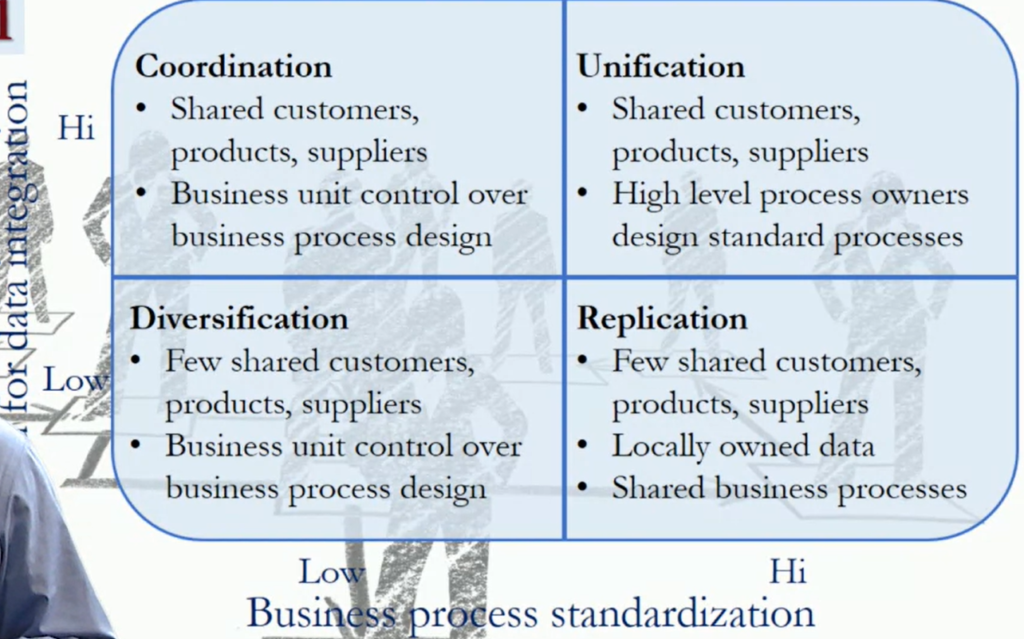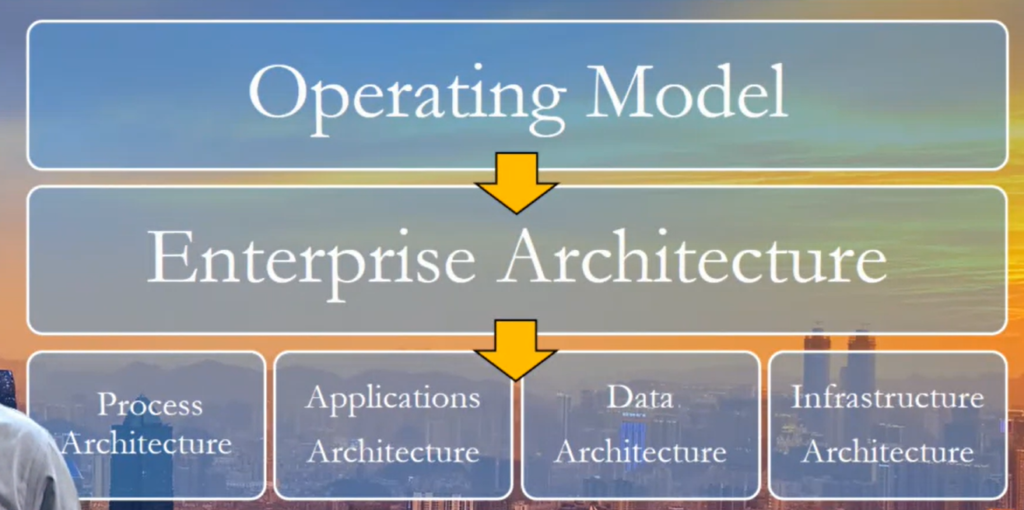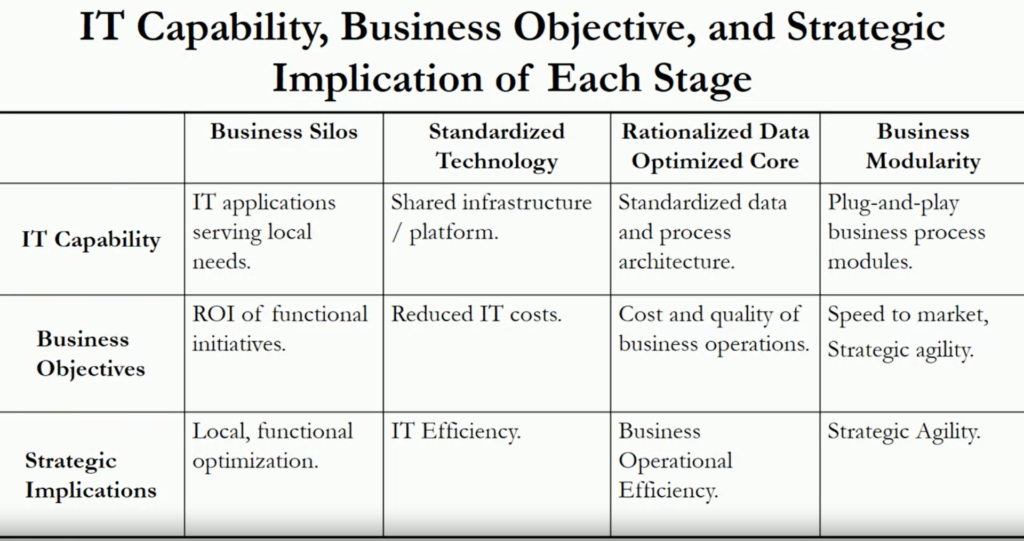Link to course: https://www.coursera.org/learn/is-it-governance/
Credit: Images and notes are from the Coursera course, however, they are summarised by me, which can’t guarantee the accuracy.
Trong trang này có summarise của bài: nên sẽ bằng tiếng Anh lẫn tiếng Việt.
IT Alignment
Lession 1: IT Governance
An Introduction to the IS Specialization
An Introduction to the Information Systems Specialization
Specialization covers key principles, policies, and best practices in information systems management
Focus areas: identifying valuable information systems projects, modeling and describing systems, enterprise system capabilities, and infrastructure options
Broad goals of the specialization:
- aligning IT strategies with organizational goals,
- formally evaluating IT investments,
- assessing portfolios of IT investments,
- encouraging prudent use of IT dollars,
- ensuring value from new information systems
IS/IT Governance: Aligning IT strategies, evaluating investments, portfolio assessment, user incentives, and system adoption strategies.
Analysis for Business Systems: Focus on SDLC, translating needs into requirements, and building/buying the right system.
Enterprise System Class: Role of enterprise systems, selecting systems, and managing ERP-related organizational change.
IT Infrastructure and Emerging Trends: Technical foundation for Cloud Computing, Mobile Communications, Cyber Security, and Blockchains.
Course Project Introduction
This summary focuses on the projects included in the four courses of the Information Systems Specialization:
1. IS/IT Governance Project:
- Defines a business problem and conceptualizes an IT system to address it.
- Describes how the system supports organizational goals and strategies.
- Performs a cost-benefit analysis with risk assessment.
- Discusses how the system fits within the organization’s IT portfolio.
- Defines user payment models and strategies for user adoption.
2. Analysis for Business Systems Project:
- Applies the Systems Development Life Cycle (SDLC) to a small project.
- Prepares analysis phase deliverables like requirements, process models, and data models.
- Follows industry standards and best practices.
3. Enterprise Systems Project:
- Develops an execution plan for selecting and acquiring an ERP system.
- Aligns with the system analysis course, building upon requirements gathering.
4. IT Infrastructure and Emerging Trends Project:
- Identifies a company using innovative IT solutions (cloud, mobile, blockchains, etc.).
- Researches the company’s challenges, how the IT solution helped, and their IT strategy refinement.
- Applies technical concepts and examples to real-world settings.
1.1-1 Personal Introduction
Prof introduction
1.1-2 Course Overview
ROI thường thấp hơn expectation. Cho nên IT/IS Governance is used to address the question: “How to make good IT investment decisions and realise the value from those investments?”
4 Modules:
- IT Alignment: align with the company goal.
- Addresses aligning IT investments with business goals and strategies.:
- What decisions need to be made?
- Who makes those decisions?
- How they make those decisions?
- Operation Model: Business process standardised across divisions in business, how much data shared across divisions in business
- Maturity of the enterprise architecture
- Addresses aligning IT investments with business goals and strategies.:
- Evaluation of IT Investments:
- Explores three estimate categories: order of magnitude, budget, and definitive estimates.
- Covers budget estimation. Operational/tactical are tangible vs. strategic benefits: intangible.
- Risk incorporation using the options approach: Risk can be resolved by: waiting or a small experiment.
- A framework for Evaluating IT Investment: Based on Strategic Objective and Technology Scope
- Portfolio Evaluation and IT Chargeback:
- Examines how to select the right set of IT investments using the IT investment portfolio concept.
- Discusses IT chargeback models (cost centers, service centers, profit centers) to allocate costs effectively.
- Change Management: make sure user use the system
- Focuses on ensuring user adoption for the new system.
- Explores 2 models of adoption of Innovation: demand-driven (benefit > cost) and supply-driven (due to knowledge barriers).
- Discusses five levers for managers to influence innovation adoption and strategies for different types of system implementations.
1.1-3 IT Alignment Part 1
Module on IT Alignment Goals:
- First goal: Define IT governance and emphasize its significance.
- Second goal: Provide a framework for IT governance, involving decision-making structures and processes.
- Third goal: Introduce the operating model and enterprise architecture maturity to align IT with business strategy.
Significance of IT Governance:
- Graph illustrates that US organizations spend around 6% of revenue on IT, with increasing investments.
- McKinsey study highlights challenges: projects 45% over budget, 7% behind schedule (due to Missing focus,…), and a 56% shortfall in expected benefits.
- Consistent industry concern, as revealed by the Society for Information Management survey, is the alignment of IT with business objectives.
- Alignment issues identified as a major contributor to project performance shortfalls.
IT Governance Definition:
- IT governance is a strategic response to ensure IT investments align with and contribute to organizational goals and strategies.
- Defined by the Institute of Internal Auditors: “Leadership, organizational structures, and processes ensuring IT supports organizational strategies”
- Gartner defines IT governance: “a set of processes ensuring effective and efficient IT use to achieve organizational goals.”
1.1-4 IT Alignment Part 2
Leadership Role in IT Governance:
- Leadership includes board directors responsible for governing IT, CIO, and board-level committees.
- Two key roles: oversight/monitoring and providing expertise to the organization and access to external IT specialists
Leadership Failure:
- Study by Michael Benrock shows that operational failures in financial services firms lead to stock price drops.
- Impact: Changes on the board include an increase in directors with IT competence and turnover in the CIO/CTO role.
- Example: Target’s data breach led to a 6% drop in share price, resulting in the resignation of the CIO and CEO.
Significance of IT Governance
- IT Governance -> IT-business alignment -> firm performance.
- IT Governance measured through mechanisms:
- steering committees
- IT investment prioritization processes.
- IT-business alignment: lead to
- Business and IT Strategy Alignment for products, processes, and markets
- Firm Performance:
- Financial performance
- Operational excellence
- Customer satisfaction.
1.1-5 IT Alignment Part 3
- Six Key Questions for IT Governance Leadership:
- How will IT change the basis of competition in our industry? (Understanding IT’s role and leveraging opportunities)
- Do our business plans reflect the full potential of IT to improve performance? (Balancing operational efficiency and strategic agility)
- Do we have the capabilities required to deliver value from IT? (Assessing human capital for leveraging IT opportunities)
- Is our IT investment portfolio aligned with opportunities and threats? (Balancing short-term and long-term needs)
- Who is responsible for realizing value from IT? (Establishing accountability in the IT organization)
- Are we comfortable with our level of IT risk? (Understanding and managing risks associated with IT investments)
The IT Governance Umbrella

- Strategic Focus of IT Governance:
- Alignment of organizational and IT strategies.
- Realization of IT opportunities.
- Tactical Elements of IT Governance:
- Realization of IT project and operations value.
- Effective management and responsible use of IT resources.
- Management of IT-related business risks.
- Compliance with IT-related laws and regulations.
Conclusion:
- IT governance involves both strategic and tactical elements.
- Strategic focus includes alignment of organizational and IT strategies, as well as realizing IT opportunities.
- Tactical elements encompass realizing value from IT projects, responsible use of resources, managing IT-related risks, and ensuring compliance with laws and regulations.
IT Governance Framework
1.2-1 A Framework for IT Governance
Key Decisions in IT Governance:
- IT Principles:
- Define IT’s role based on business objectives.
- Example: Standardizing business processes for operational efficiency.
- IT Architecture:
- Identify key business processes, applications, data elements, and supporting technologies.
- Determine standardization and data integration levels.
- IT Infrastructure:
- Define computing power, networks, storage services, and common applications.
- Decide central vs. local provisioning of infrastructure services.
- Business Applications:
- Software applications serving business needs.
- Decide corporate vs. local applications based on business requirements.
- IT Investment:
- Determine how much the firm’s IT investment? Which specific IT projects to fund?.
Nature of Decisions:
- Technical decisions: IT infrastructure and IT architecture, made by senior IT executives.
- Managerial decisions: IT principles, IT investment, and prioritization.
- Hybrid decisions: Business requirements involve both user preferences and technological feasibility.
1.2-2 Who Makes the Decisions
- Business Monarchy:
- Business executives (with/without CIO) make decisions.
- Centralized approach, suitable for efficiency-focused organizations.
- IT Monarchy:
- Senior IT executives make key IT decisions.
- Centralized approach, focuses on IT efficiency.
- Feudal Approach:
- Business unit leaders or Line Managers make IT decisions.
- Decentralized approach, suitable for differentiation or responsiveness.
- Federal Approach:
- C-Level executives and business units make decisions.
- Hybrid: Balances efficiency and responsiveness, may include IT participation.
- IT Duopoly:
- IT and business executives jointly make key decisions.
- Hybrid: Collaborative approach, aiming for balanced decision-making.
- Anarchy:
- Each individual user makes their own IT decisions.
- Highly decentralized, may lead to autonomy but lacks coordination.
Centralization Trends in US Economy:
- Society for Information Management survey reveals a high level of centralization in IT governance.
- Centralization persists in decisions related to IT architecture, infrastructure, applications, and purchasing.
- Increasing trend toward more centralization.
CIO Reporting Structure:
- 40% of CIOs report to the CEO, and 30% report to the CFO.
- Banker et al. study suggests CIO reporting should align with organizational strategy.
- CIO reporting to CEO for differentiation and innovation, to CFO for efficiency.
1.2-3 How IT Decisions are Made
Decision-Making Structures: what structures are used to align IT decisions with business decisions

Decision-Making Processes: what processes are followed to align IT decisions w business decisions.
- IT Investment Approval Process:
- Standardized IT Investment approval evaluates alignment with business strategy, financial analysis, and risk.
- IT Architecture Exception Process:
- Assess whether a new project follows to defined IT standards or requires an exemption.
- Service Level Agreement and Chargeback Process:
- Defines IT services, their cost, aligns pricing with market standards, assesses IT organization’s efficiency.
- Project and Business Value Tracking Process:
- Tracks project development, ensures benefits align with expectations.
Best IT Governance Approach:
- No universal model, depends on business goals.
- Decision-making structures and processes align with business objectives.
- Considerations include synergy and autonomy trade-offs.
Common IT Governance Approaches:
- Profitability Focus:
- Business monarchy for IT principles, infrastructure strategies, architecture, and IT investment.
- Federal approach for business applications (corporate-level decisions for enterprise-wide, local decisions for business units).
- Growth Focus:
- IT duopoly for IT principles and IT investment prioritization.
- IT monarchy for infrastructure strategies and IT architecture.
- Federal approach for business applications (corporate-level decisions for enterprise-wide, local decisions for business units).
Lesson 3: Operating Model and the Maturity of Enterprise Architecture
1.3-1 Key Principles and Practices
“Operating Model“: the degree to which a company standardises its core processes and integrates its data.
- Processes: There is a central body that coordinate all business processes.
- Data: data is shared across different business units

| Data – Hi | Coordination | Unification |
| Data – Low | Diversification | Replication |
| Process – Low | Process – Hi |
1.3-2 Operating Model and Enterprise Architecture
“How operating model relates to enterprise architecture?”
Enterprise Architecture: organising logic for business processes, applications, data, and infrastructure technologies that enable a firm’s business strategy.
- It’s like a city plan (blueprint)…

4 IT Architecture Stages:
- Application Silo: The architecture of individual application. Diversification operating model.
- Standardized Technology: enterprise-wide standards for IT infrastructure. Follow standard for infrastructure component (the above 1 doesn’t follow any). Not yet data or processes. Diversification operating model.
- Rationalized Data/Optimized Core: Enterprise-wide standards include standardization of data and process. Coordination, Replication, Unification operating model.
- Modular Architecture: org allows local differentiation. In addition to having standard, enterprise allows BU to modify the standards to meet local needs. Coordination, Replication, Unification operating model.
1.3-3 Application Silo Stage
Application Silo
- Business of a function, a BU or geography.
- Data closely tie to each application
- Biz users focus on the value of their apps
- Benefit and risk:
- Local optimization: no constraint on others.
- Can be funded easily on a simple cost-benefit analysis. System benefits are often predictable and easily measured.
- Risk: unconnected app, no integration
- High cost of maintainance
Standardised Technology stage:
- IT efficientcy
- Increase maintainablity, security.
- Conflict between users desires vs IT desire
- Funding infrastruture is harder.
Rationalized Data/Optimized Core
- Data is centralised and available to other apps
- Core business processes: standardise using apps.
- Benefit:
- Business process efficiency
- Standardisation enables innovation.
- Risk: Business standardization harder to sell to managers than technology standardization
Modular Architecture
- Meet local meets.
- Successful experiments: standardised and made available to others.
- Benefit:
- Oppor for strategic agility, innovation and responsiveness
- Risk: flexibility without rationalized and optimized core may lead to application silo
As one move across stages firms tradeoff local flexibility for global flexibility
1.3-4 Implications of Enterprise Stages

Key Governance Mechanism in the Business Silo Stage:
- Business Case
- Standardised project methodology: a disciplined approach to converting an approved project into an improved process.
Standardized Tech Stage:
- IT Standards Committee: senior IT executives define tech standards and recognize when to retire and when to update standard
- Infrastructure Funding and Renewal Process
- A formal architectural compliance and exception process
Rationalised data Stage:
- Enterprise wide process owner
- Enterprise wide data standard
Modular Stage
- Define boundaries for business experiments
- Component funding and approval processes: when succeeded or failed
Module Wrap up
1.4.-1 Module 1 Summary
Q: Why is IT governance important?
A: IT governance helps ensure that IT investments align with organizational goals, leading to improved performance.
Q: What are the key components of IT governance?
A: IT governance includes decisions about what, who, and how IT decisions are made, covering technical, managerial, and hybrid aspects.
Q: What are the different types of IT governance models?
A: Models can be centralized, decentralized, or federal, with the choice influenced by factors like firm size and strategy.
Q: Who should the CIO report to?
A: The best reporting structure depends on the organization’s strategic positioning.
Q: How are IT decisions made?
A: Various decision-making structures and processes are used to align IT decisions with organizational goals.
Q: Is there a one-size-fits-all IT governance approach?
A: No, the best approach depends on the organization’s specific goals and needs.
Q: What is the relationship between operating models and enterprise architecture?
A: The operating model (process, application, data, and infrastructure standardization) determines the organization’s enterprise architecture.
Q: How does enterprise architecture evolve?
A: It typically progresses from individual application silos to standardized technology, rationalized data, and finally modular stages allowing for customization and continuous improvement.
Q: What are the key governance mechanisms for each stage of the architecture evolution?
A: They vary depending on the stage, from business cases for individual applications to IT standards committees, process ownership, and experiment boundaries in the modular stage.
Quiz: https://huongvan.com/?p=511 Note: I don’t share password.
Leave a Reply